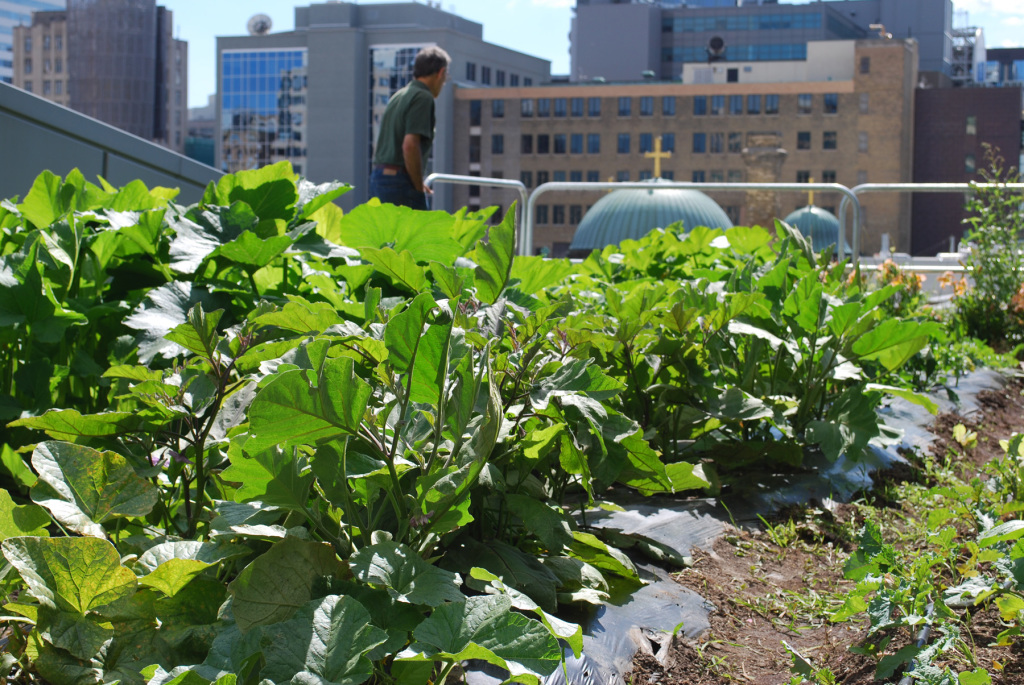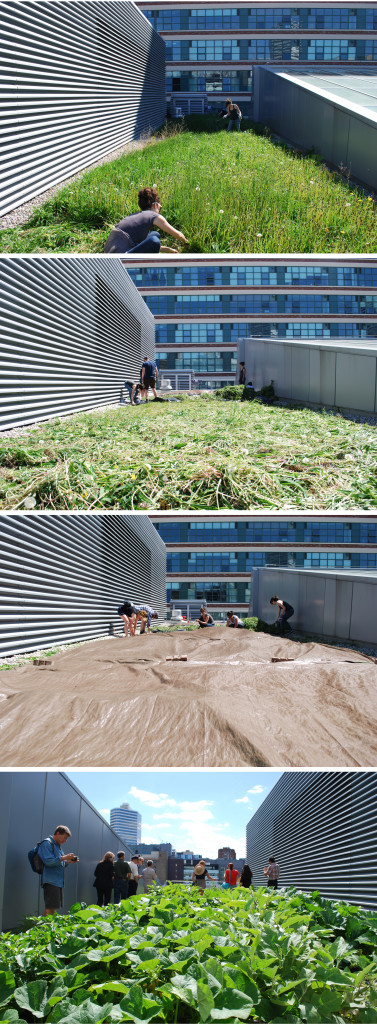Toronto-style thin farming

Ryerson University’s George Vari Engineering and Computing Centre rooftop farm || photo by Vincent Javet, Green Roofs for Healthy Cities
As ornamental green roofs increasingly coat our skylines, some urbanites have begun re-purposing older vegetated rooftops for agriculture. One example, north of the border in Toronto, is Ryerson University’s George Vari Engineering and Computing Centre, constructed in 2004. The building supports a 6-inch thick extensive green roof that was intended to moderate indoor temperature, manage stormwater, and give students a living research platform. A monoculture of widely spaced daylilies (Hemerocallis spp.) initially inhabited the green roof, which was quickly colonized by more than 30 volunteer plant species, even trees!

Four step weed-to-farm conversion || photos by Vincent Javet, Green Roofs for Healthy Cities
Seven years after construction, the university’s edible gardening group, Rye’s HomeGrown, began ruminating on whether the green roof should be re-purposed for agriculture. Two years later, in 2013, students, faculty, and community members finally rolled up their sleeves to replace the roof’s weeds with edibles in a small test plot.
Volunteers began by cutting back the weeds and leaving the clippings in place. They then laid tarps over top of the plot for several weeks – a common garden preparation technique – in order to kill the remaining root systems and begin to decompose the underlying plant material. Next, the volunteers removed the tarps, spread two inches of compost over the plot, and installed a surface-drip irrigation system. The first growing season produced an impressive 500 pounds of nightshades, cucurbits (squash, melons, etc.), leafy greens, and herbs.
Once the pilot project proved successful, Rye’s HomeGrown worked closely with the university’s Campus Facilities and Sustainability to convert the remaining green roof area, 10,000 square feet (almost 1/4 acre), into a rooftop farm. The expansion occurred in early summer 2014, thanks to the help of 17 Farm the Roof Program participants who each volunteered five hours per week. According to the Rye’s HomeGrown website, the full-scale farm is intended to produce food and, “provide growing knowledge, education and hands-on opportunities for interested participants.” Rye’s HomeGrown’s early estimates predicted that the expanded farm would yield 7,500 pounds of vegetables and herbs per year. The produce is distributed to the university’s cafeteria, a local farmers’ market, and community supported agriculture (CSA) members.
Will other Torontonians follow suit and convert their extensive green roofs into edible roofscapes? The odds look good! Toronto’s skyline boasts an abundance of green thanks to the city’s 2009 Green Roof Bylaw, which made Toronto the first North American city to require green roofs on new construction. The bylaw specifies that all new buildings larger than 2,000 square meters (21,500 square feet) contain at least 20%-60% green roof coverage, depending on project size. Residential buildings less than six stories are exempt. With so many new commercial, mixed-use, and multi-family residential buildings, the opportunity to farm the skyline is continually growing.
—
Did you enjoy reading about this topic? You may also like these additional articles on thin farming by EAT UP author Lauren Mandel: “Roof-to-Table” (Landscape Architecture Magazine, 2014), “Thin Farming” (Urban Farm Magazine, 2014), and “Skyline Vegetable Convention” (EAT UP Blog, 2013).
 EAT UP
EAT UP